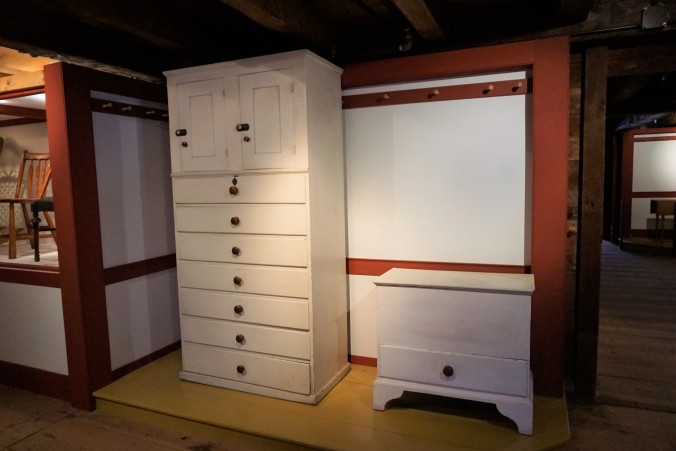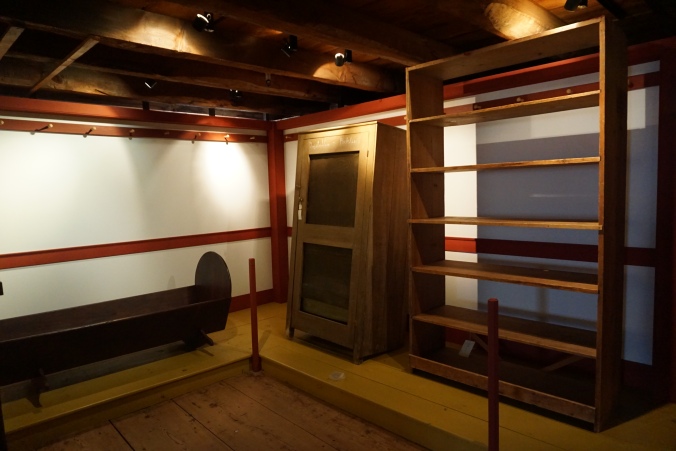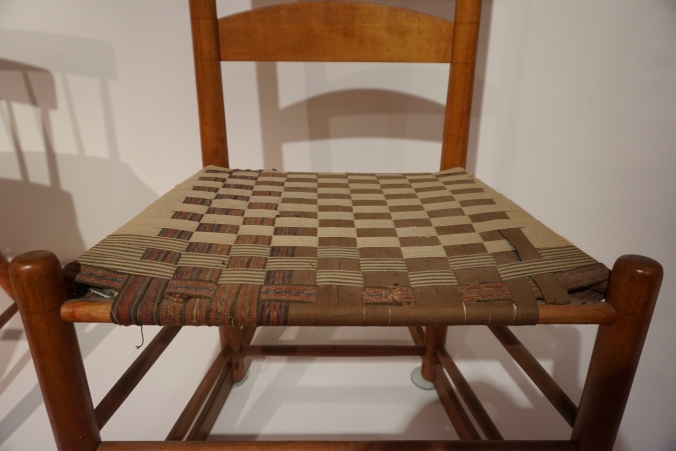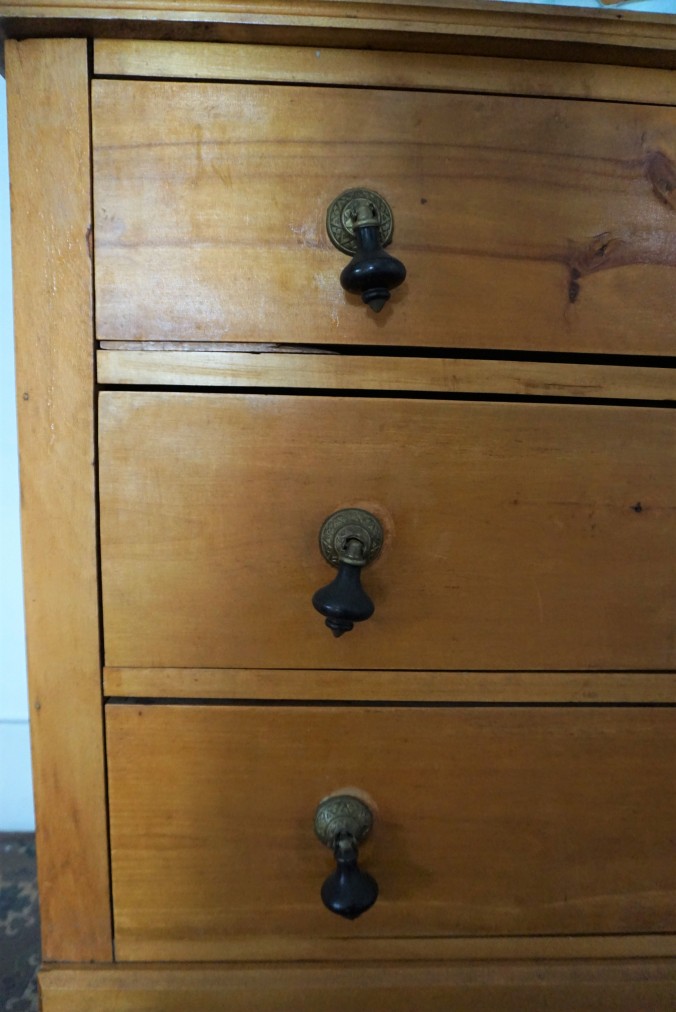This is a longer version of a post written as part of my collections internship at Canterbury Shaker Village for their Facebook Page, published on March 17, 2018.
Visiting museums is one of my favorite hobbies, and working at museums makes me think about them in a whole new light. As my coworkers and I here at Canterbury Shaker Village are doubling down on putting together a new exhibit on furniture made and owned by the Canterbury Shakers – “Furnished by Faith: Shaker Stories in Wood” – I’ve been thinking a lot about all the tough decisions that go into crafting a museum exhibition. There is so much to consider.

Shaker-made cupboard over drawers and blanket chest that will be part of our exhibit at Canterbury Shaker Village.
First off the big questions: What story do you want to tell? What artifacts do you have to display? What information will visitors find interesting? But then there’s the nitty gritty questions: What fits into the exhibit space? We had a couple chairs we were dying to display, but they were an inch or two too tall to fit into our chair display case. What objects have research done on them already? With such an expansive collection as we are lucky to have at CSV, sometimes we don’t know the date an item was made or who made it, which can make it hard to interpret in an exhibit.

A panoramic of our chair case, part of our larger furniture exhibit. We were lucky that we found a lot of chairs that we loved that fit in the 43-inch tall case…some beloved chairs from the collection were simply too big to include, however.
These questions can open up whole new avenues for research that, while fascinating, you sometimes don’t have enough time to pursue when you’re under the pressure of a deadline. Recently, we’ve been trying to find out more about an adult cradle in our collection that we want to exhibit. It can be baffling to realize something that has been interpreted for years may not have very much information out there about it.

The adult cradle, to the left, is one item that sent us into a research rabbit hole.
In addition, there’s also the difficulty of moving items to go on exhibit. My fellow intern and I have been joking that we’ve really been building our upper body strength during the internship as we move furniture pieces back and forth between buildings – a task New Hampshire weather does not really try to cooperate with us on! In the end, a moving company had to be hired for a lot of the large pieces, but this can cost a pretty penny. Not to mention that every time an artifact is moved, it is put in danger of being damaged. Accidents can happen, especially after a long day of trying to maneuver huge two-hundred year-old pieces around tight corners and through tiny doorways.

This large piece can no longer be moved because it was taken apart too many times to be moved to different exhibits, leaving it in a fragile state. Essentially you would have to design an exhibit around this piece!
There’s also the consideration of the condition objects are in: something may be an extraordinary example of a particular style of craftsmanship, for instance, but that often means that it’s been displayed on exhibit before many times. It’s important to give objects rest in humidity, temperature, and light-controlled archival storage so that they don’t get too faded by light or damaged by the wear and tear that comes from being on display – visitors who ignore the “Do not touch” signs, the stress that hanging can put on textiles, the occasional outbreak to bugs that eat textiles, the exposure of metal objects to things in the air that oxidize them, etc.

This mismatched woven cloth tape seat is not the prime example of a Shaker-made rocker people might expect to see on exhibit, but we decided to give the most-loved examples a rest from being on exhibit. Plus, we thought this told an interesting story about seats being repaired and altered over time.
Oftentimes what has been on exhibit is the best set of examples in a collection with the most research done on them, but it’s important to give them a rest – and to let other objects in the collection have their time in the spotlight, even if it means working a little harder to tell their story or upsetting some people who want to see “the classics”.

Shaker chairs and stools all ready to be on exhibit.
Lastly, there are considerations of how visitors will interact with the exhibit and text. What questions do you want visitors to consider? What do you want them to learn? What myths do people commonly believe about your topic that you hope to dispel? Are you repeating the same themes too much or are they not clear enough? Are your main points clear? Is there too much text? Too little? In what order will a visitor walk through the room and read the labels? Are objects too easy for a visitor to touch or – heaven forbid – walk off with? Is the exhibit accessible to people in wheelchairs or with sight or hearing difficulties?

Two Shaker sewing desks that will be on exhibit. We had to consider which way the platform should be oriented for the most visual appeal and to prevent the platform from getting in the way of visitors.
Are there places where it would be easy for someone to trip or knock into something? Are there going to be events held in the space? There are so many more questions, but I’ll leave it off there. At the end of the day (and the opening of the exhibit), what matters is that we, as museum workers, are doing our utmost to be good stewards of the objects and stories in our collection by keeping in mind how to best preserve them in as good condition as possible for future generation while allowing them to tell the many stories wrapped up inside to as many visitors as possible through clear, engaging interpretation.

Yours truly getting down and dirty spackling the exhibit case.
Other posts to peruse:
This Old House: The Canterbury Tales, Pt. 5
Victorian Furniture in a Shaker Village (The Canterbury Tales, Pt. 6)
Antique Bandboxes: The original Shabby Chic (The Canterbury Tales, Pt. 7)










